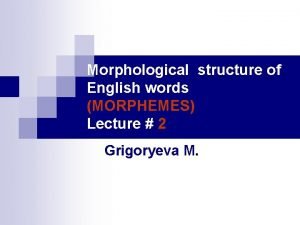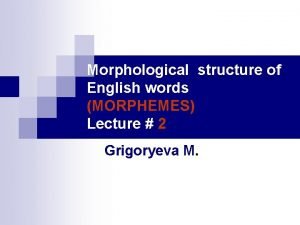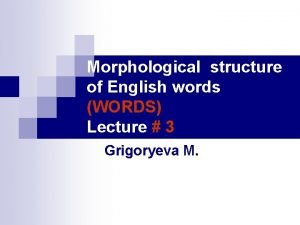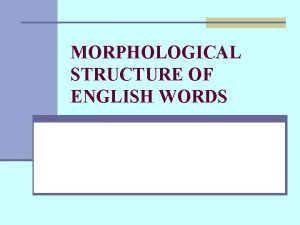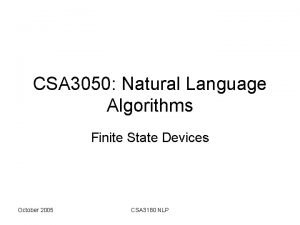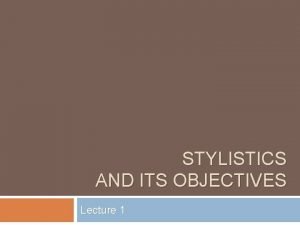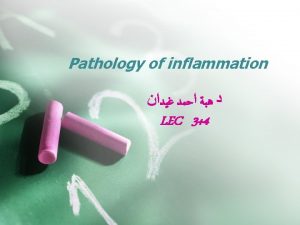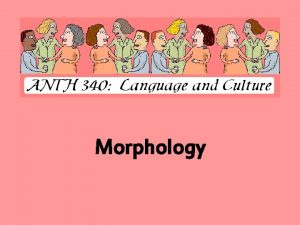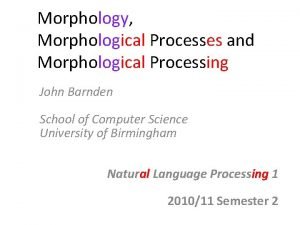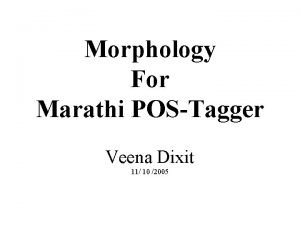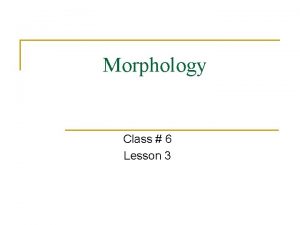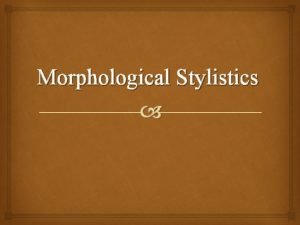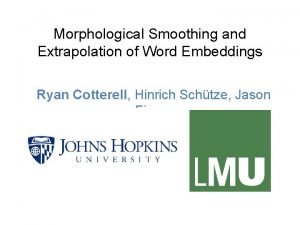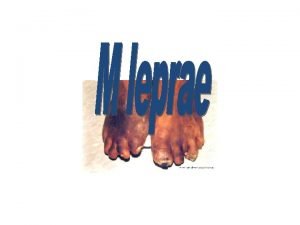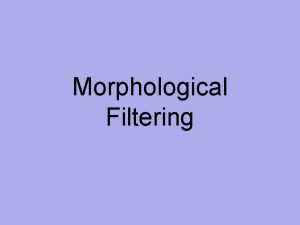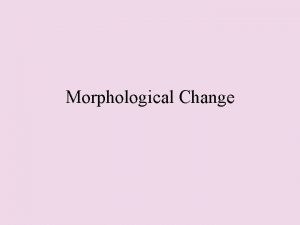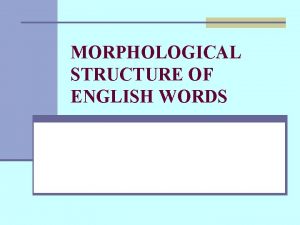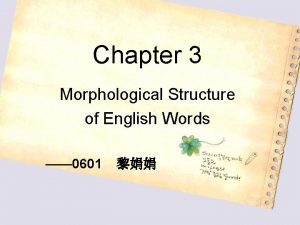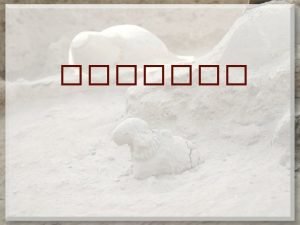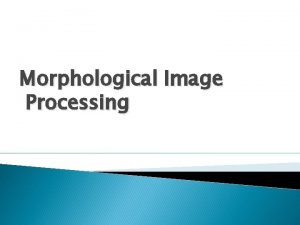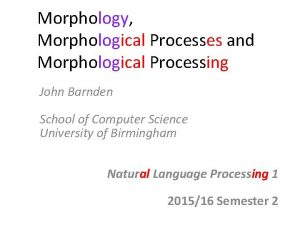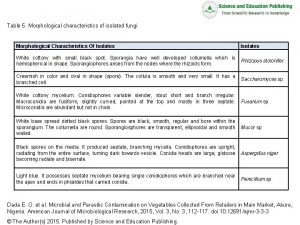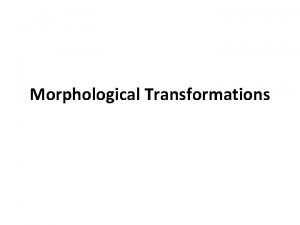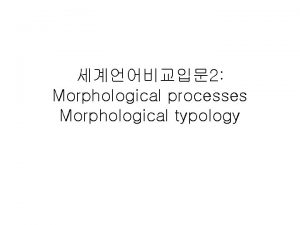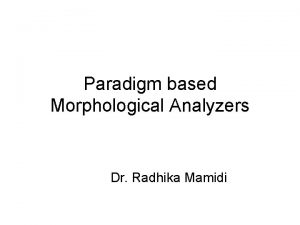Morphological structure of English words WORDS Lecture 3


















- Slides: 18

Morphological structure of English words (WORDS) Lecture # 3 Grigoryeva M.

Language Units Morphemes n Word groups n Phraseological units n

MORPHEME n n morphe – “form” - eme “the smallest unit” Morphemes- are the smallest meaningful unit of form n cannot be segmented into smaller units n can occur in speech only as constituent parts of words n are divided into lexical morphemes and grammatical morphemes

Non-root morphemes (Derivational) n Inflectional morphemes (inflections) endings n Affixational morpheme (affixes) prefixes functional suffixes derivational

STRUCTURAL TYPES OF WORDS (Дубенец Э. М. ) According to the number of morphemes words may be monomorphic simple polymorphic affixed (derived) compound-affixed

Monomorphic (root) words n Consist of one-root morpheme EX small, dog, make SIMPLE one root morpheme + (functional affix) EX asked, seldom, cat, longer

POLYMORPHIC WORDS n Affixed ( derivatives) = one root morpheme + one or more derivational affixes or functional affix (inflexion) EX. acceptable, outdo, dislikes, discouragement n Compound words = two or more root morphemes + functional affix (inflexion) EX. eye+balls, wait- and- see n Compound-affixed words = two or more root morphemes + one or more derivational affixes + functional affix (inflexion) EX. job – hoppers, autotimer

STRUCTURAL TYPES OF WORDS (Зыкова И. В. ) According to the number of morphemes words may be monomorphic polymorphic monoradical polyradical

MONORADICAL words Radical-suffixal (one root morpheme + one or more suffixal morphemes) Ex acceptable, acceptability n Radical-prefixal (one root morpheme + a prefixal mopheme Ex unbutton n Prefixo-radical-suffixal (one root morpheme + prefixal and suffixal morphemes) Ex disagreeable n

POLYRADICAL words Two or more roots without affixational morphemes Ex book- stand, lamp-shade n Two roots or more + one or more affixational morphemes Ex safety-pins, pen-holder n

Morphemic analyses Segmenting words into the constituent morphemes the method of Immediate and Ultimate Constituents

Procedure of morphemic analyses Based on a binary principle when each stage of the procedure involves two components the word immediately breaks into- The Immediate Constituents (ICs) n Each IC at the next stage in its turn is broken into the smallest meaningful elements incapable of further division – The Ultimate Constituents (UCs) n Ex friendliness 1) Friendly- IC + - ness 2) Friend- UC + - ly The word consists of 3 UCs UC UC

Derivatonal structure is the nature, type and arrangement of the immediate constituents (ICs) of the word. Derivational base Is the part of the word that determines its individual lexical meaning Derivational affixes Are immediate constituents (ICs) of derived words

Derivational patterns (DP) Is a regular meaningful arrangement, a structure that imposes rules on the order and the nature of the derivational bases and affixes that may be brought together. DPs represent the derivational structure at different levels: a) structural types. Patters of this level are structural formulaswhich specify the class membership of Immediate Constituents and the directions of motivation V N A + -sf N

According to structural formulas all words may be classified into: Suffixal derivatives n Prefixal derivatives n Conversions n Compound words n blackness rewrite a cut music-lover

b) structural patterns specify the base classes and individual affixes which refer derivatives to specific parts of speech EX The DP n + -ish A signals a set of adjectives with the lexical meaning of resemblance EX The DP a + -ish A signals a set of adjectives meaning a small degree of quality

c) Structural –semantic patterns specify semantic peculiarities of bases and individual meanings of affixes EX n + -ess EX n+ -y N A (a female animate being) - lioness (resemblence) - birdy

Morphemes and Words WORD n n n particular meaning particular sound form capable of a particular grammatical employment able to form a sentence autonomous MORPHEME n n n particular meaning particular sound form not autonomous constituent part of a word not divisible into smaller meaningful units
 Morpheme ex
Morpheme ex Morphological structure of english words examples
Morphological structure of english words examples Polyradical words
Polyradical words Morphological structure of english words
Morphological structure of english words 01:640:244 lecture notes - lecture 15: plat, idah, farad
01:640:244 lecture notes - lecture 15: plat, idah, farad Morphological analysis of words example
Morphological analysis of words example English literature lecture
English literature lecture English language lecture
English language lecture Morphological stylistics
Morphological stylistics Morphology pattern of acute inflammation
Morphology pattern of acute inflammation Agglutinative language
Agglutinative language Morphological processes compounding
Morphological processes compounding Meaning of morphology in marathi
Meaning of morphology in marathi Word tree diagram morphology
Word tree diagram morphology Morphological stylistics
Morphological stylistics Morphological smoothing
Morphological smoothing Morphological patterns of chronic inflammation
Morphological patterns of chronic inflammation Natorial legs
Natorial legs Bacteriological index formula
Bacteriological index formula
